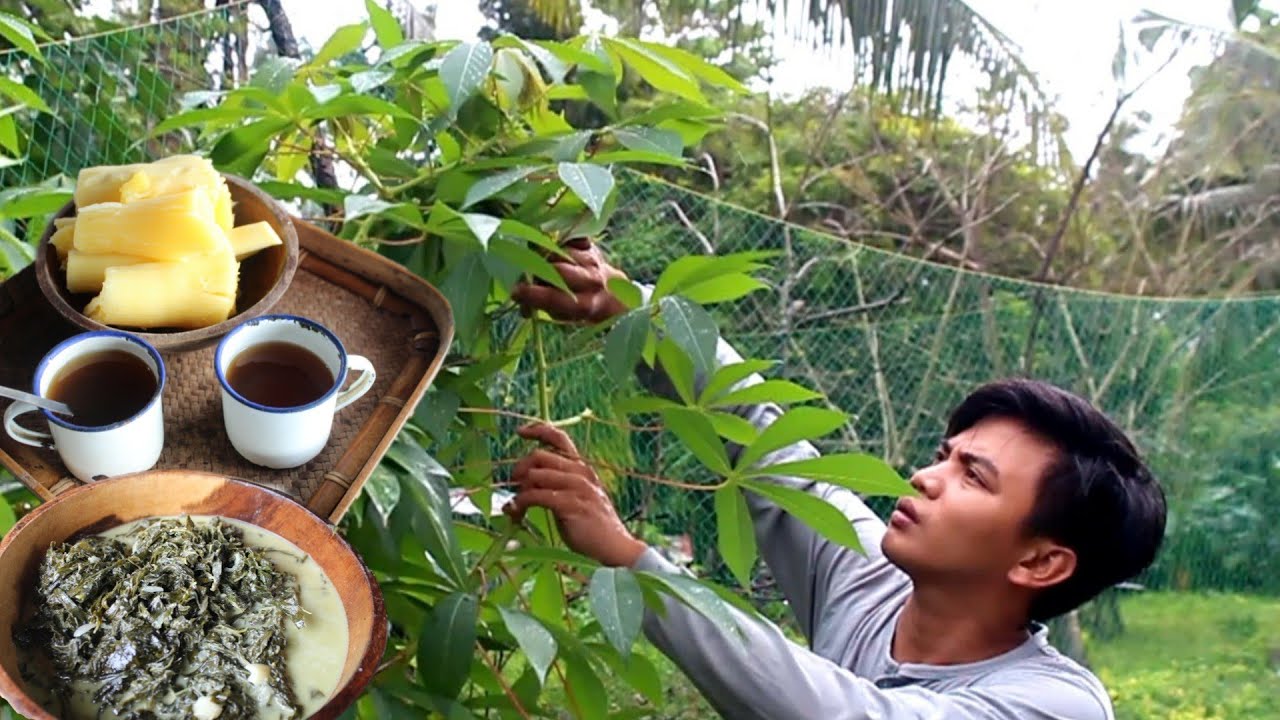How to Use Cassava Leaf in Your Daily Diet for Better Health sets the stage for this enthralling narrative, offering readers a glimpse into a story that is rich in detail and brimming with originality from the outset. Cassava leaf, a vibrant green vegetable often overlooked, is a nutritional powerhouse packed with vitamins, minerals, and antioxidants.
It has been a staple in many cultures for centuries, celebrated for its versatility in the kitchen and its potential health benefits. This article delves into the fascinating world of cassava leaf, exploring its nutritional profile, health benefits, culinary uses, and traditional applications.
Introduction to Cassava Leaf
Cassava leaf, also known as cassava greens or Manihot esculenta leaves, is a highly nutritious leafy green vegetable that is a staple food source in many parts of the world, particularly in tropical and subtropical regions. It has been a part of traditional diets for centuries, and its popularity is growing due to its versatility, affordability, and impressive nutritional profile.
Nutritional Profile of Cassava Leaf
Cassava leaf is a nutritional powerhouse, packed with essential vitamins, minerals, and antioxidants. It is a rich source of:
- Vitamins:Vitamin A, Vitamin B6, Vitamin C, Vitamin E, and Vitamin K
- Minerals:Calcium, Iron, Magnesium, Phosphorus, Potassium, and Zinc
- Antioxidants:Carotenoids, Flavonoids, and Phenolic compounds
Key Vitamins and Minerals
Cassava leaf stands out for its high content of vitamin A, vitamin C, and iron. Vitamin A is crucial for maintaining healthy vision, immune function, and skin health. Vitamin C is a potent antioxidant that supports immune function, collagen production, and wound healing.
Iron is essential for red blood cell production and oxygen transport throughout the body.
Antioxidants in Cassava Leaf
Cassava leaf contains a wide array of antioxidants, including carotenoids, flavonoids, and phenolic compounds. Antioxidants protect cells from damage caused by free radicals, which can contribute to chronic diseases. Carotenoids, such as beta-carotene, are converted into vitamin A in the body.
Flavonoids exhibit anti-inflammatory and anti-cancer properties. Phenolic compounds have been linked to improved heart health and reduced risk of certain cancers.
Historical and Cultural Significance
Cassava leaf has a long history of use in various cultures. In Africa, cassava leaf is a traditional staple food in countries like Nigeria, Ghana, and Cameroon. It is often prepared in stews, soups, and sauces. In Southeast Asia, cassava leaf is commonly used in dishes like “laksa” and “curry.” In South America, cassava leaf is incorporated into traditional recipes, such as “tapioca” and “farofa.”
Health Benefits of Cassava Leaf
Cassava leaf, a versatile and nutritious green leafy vegetable, is gaining recognition for its impressive health benefits. It is packed with essential nutrients, including vitamins, minerals, and antioxidants, which contribute to its potential role in promoting overall well-being.
Digestive Health
Cassava leaf is known for its potential to improve digestive health. It is a good source of dietary fiber, which is crucial for maintaining a healthy digestive system. Fiber adds bulk to stool, promoting regular bowel movements and preventing constipation.
Additionally, cassava leaf contains enzymes that aid in the breakdown of food, facilitating better digestion.
Cassava leaf, a nutritional powerhouse, is often overlooked in the culinary world. Its versatility allows it to be incorporated into a variety of dishes, adding a unique flavor and texture. Similar to nurturing a Jacaranda tree for vibrant blooms, cultivating a healthy diet requires a consistent and thoughtful approach.
By adding cassava leaf to your meals, you’re not only enriching your diet but also contributing to a healthier and more vibrant lifestyle.
Blood Sugar Regulation
Cassava leaf may play a role in blood sugar regulation. Studies have shown that consuming cassava leaf can help lower blood sugar levels in individuals with type 2 diabetes. This effect is attributed to the presence of compounds in cassava leaf that enhance insulin sensitivity, allowing the body to utilize glucose more effectively.
Immune System Health
Cassava leaf is rich in antioxidants, which are compounds that protect cells from damage caused by free radicals. Free radicals can contribute to inflammation and weaken the immune system. The antioxidants in cassava leaf help combat these harmful molecules, strengthening the immune system and reducing the risk of infections.
Heart Health
Cassava leaf may contribute to heart health by reducing the risk of cardiovascular diseases. It contains potassium, a mineral that helps regulate blood pressure. Additionally, cassava leaf is low in sodium, which further supports healthy blood pressure levels.
Furthermore, the fiber content in cassava leaf can help lower cholesterol levels, another important factor in maintaining heart health.
Chronic Disease Prevention, How to Use Cassava Leaf in Your Daily Diet for Better Health
The nutrient-rich composition of cassava leaf may offer protection against chronic diseases. Its antioxidants help combat oxidative stress, a key factor in the development of chronic diseases. Furthermore, cassava leaf’s potential to regulate blood sugar levels and lower cholesterol levels contributes to a reduced risk of developing conditions like type 2 diabetes and heart disease.
Ways to Incorporate Cassava Leaf into Your Diet

Cassava leaf, a nutrient-rich green, can be a delicious and healthy addition to your diet. It’s packed with vitamins, minerals, and antioxidants, making it a valuable addition to various dishes. With its mild, slightly bitter flavor, cassava leaf blends well with a variety of ingredients, allowing you to enjoy its health benefits in many creative ways.
Recipes Featuring Cassava Leaf
Cassava leaf is a versatile ingredient that can be used in various dishes. Here are some popular recipes that showcase its unique flavor and nutritional value:
- Cassava Leaf Soup: A hearty and flavorful soup, cassava leaf is often combined with vegetables like tomatoes, onions, and peppers, along with spices like garlic and ginger. It’s a popular dish in many African and Southeast Asian countries, where it’s often served with rice or bread.
- Cassava Leaf Stew: A slow-cooked stew, cassava leaf is often simmered with meat or fish, vegetables, and spices. The slow cooking process allows the flavors to meld together, creating a rich and satisfying dish.
- Cassava Leaf Salad: A refreshing and light salad, cassava leaf is often combined with other leafy greens, vegetables, and a light dressing. It’s a great way to enjoy the nutritional benefits of cassava leaf while adding a unique flavor to your salad.
- Cassava Leaf Stir-Fry: A quick and easy stir-fry, cassava leaf is often combined with other vegetables, tofu, or meat. It’s a popular dish in many Asian countries, where it’s often served with rice or noodles.
Preparing Cassava Leaf
Cassava leaf can be prepared in various ways, each offering a unique flavor and texture. Here are some common methods:
Preparation Method |
Description |
Tips |
|---|---|---|
Steaming |
Steaming is a gentle cooking method that preserves the nutrients and flavor of cassava leaf. It involves placing the leaves in a steamer basket over boiling water. |
Steam cassava leaf for about 10-15 minutes, or until tender. |
Stir-Frying |
Stir-frying is a quick and easy cooking method that adds a nice flavor to cassava leaf. It involves quickly cooking the leaves in a hot pan with oil and spices. |
Stir-fry cassava leaf for about 5-7 minutes, or until tender-crisp. |
Boiling |
Boiling is a simple cooking method that softens the cassava leaf. It involves simmering the leaves in boiling water for a few minutes. |
Boil cassava leaf for about 5-10 minutes, or until tender. |
Soup |
Cassava leaf can be added to soups for a nutritious and flavorful boost. It’s often simmered in soups with other vegetables and spices. |
Add cassava leaf to soup towards the end of cooking, as it cooks quickly. |
Selecting and Storing Cassava Leaf
When selecting cassava leaf, choose leaves that are fresh, green, and free of any blemishes. Avoid leaves that are wilted or yellowed, as these may be past their prime. Store fresh cassava leaf in a plastic bag in the refrigerator for up to 3 days.
Cassava Leaf in Traditional Medicine: How To Use Cassava Leaf In Your Daily Diet For Better Health

Cassava leaf has been a staple in traditional medicine practices for centuries, particularly in tropical regions where cassava is a major food source. Its use is rooted in the belief that the plant’s leaves possess potent medicinal properties capable of treating a wide range of ailments.
Traditional Applications of Cassava Leaf
The use of cassava leaf in traditional medicine varies significantly across different cultures. However, certain applications are common across various regions.
- Treating Anemia:Cassava leaves are rich in iron, a vital component of red blood cells. Traditional healers often recommend cassava leaf preparations to address iron deficiency and anemia, particularly in pregnant women and children.
- Managing Diabetes:Some traditional medicine practices utilize cassava leaf to help regulate blood sugar levels. The leaves are believed to contain compounds that can enhance insulin sensitivity, potentially aiding in diabetes management.
- Anti-Inflammatory Properties:Cassava leaf extracts have been used to treat inflammatory conditions such as arthritis and skin infections. The leaves contain anti-inflammatory compounds that may help reduce swelling and pain.
- Promoting Wound Healing:In some cultures, crushed cassava leaves are applied topically to wounds and cuts to accelerate healing. The leaves are believed to have antibacterial and antiseptic properties that help prevent infection.
Comparative Uses of Cassava Leaf Across Cultures
The specific applications of cassava leaf in traditional medicine differ depending on cultural practices and regional beliefs.
- Africa:In many African cultures, cassava leaves are commonly used to treat malaria, diarrhea, and dysentery. They are also employed as a natural remedy for stomach ailments and skin infections.
- South America:Traditional healers in South America often utilize cassava leaves for treating respiratory problems, such as bronchitis and asthma. They are also believed to possess anti-cancer properties.
- Southeast Asia:In Southeast Asia, cassava leaves are frequently used to address digestive issues, including constipation and indigestion. They are also incorporated into traditional remedies for fever and headaches.
Scientific Evidence and Research
While traditional practices highlight the potential benefits of cassava leaf, scientific research is ongoing to validate these claims. Studies have shown that cassava leaf extracts possess antioxidant, anti-inflammatory, and antimicrobial properties, supporting its traditional uses in treating various ailments. However, further research is needed to establish the efficacy and safety of cassava leaf for specific medical conditions.
“The use of cassava leaf in traditional medicine is a testament to the wisdom and knowledge accumulated over generations. While scientific evidence is still emerging, traditional practices offer valuable insights into the potential health benefits of this versatile plant.”
Safety Considerations
While cassava leaf offers various health benefits, it’s crucial to consider potential safety aspects and consume it responsibly. Like any food, there are certain factors to keep in mind to ensure safe and healthy consumption.
Potential Side Effects and Allergies
Consuming cassava leaf in excessive quantities or without proper preparation can lead to certain side effects. Some individuals might experience gastrointestinal discomfort, such as nausea, vomiting, or diarrhea. Additionally, cassava leaf contains cyanide compounds, which can be toxic if not properly processed.
Cassava leaf, a nutrient-rich vegetable, can be a valuable addition to your daily diet, offering numerous health benefits. While exploring the culinary uses of cassava leaf, consider enhancing your home landscape with the striking Jacaranda tree, a beautiful addition that can transform your garden.
How to Achieve a Beautiful Garden with Jacaranda Tree: Expert Growing and Care Tips offers expert advice on cultivating this stunning tree. Once you’ve added a touch of vibrant purple to your outdoor space, you can continue to reap the health benefits of incorporating cassava leaf into your meals.
However, the levels of cyanide are generally low in cooked cassava leaves and are unlikely to cause harm when consumed in moderation. It’s essential to note that some individuals may be allergic to cassava leaf, exhibiting symptoms like skin rashes, itching, or swelling.
If you experience any adverse reactions, it’s crucial to discontinue consumption and consult a healthcare professional.
Moderation and Proper Preparation
Moderation is key when incorporating cassava leaf into your diet. While it offers various benefits, consuming excessive amounts may lead to unwanted side effects. It’s recommended to start with small portions and gradually increase intake as needed. Proper preparation is also crucial to minimize potential risks.
Boiling or steaming cassava leaves for a sufficient duration helps reduce cyanide levels and improves digestibility. Additionally, using fresh, high-quality cassava leaves is essential to avoid contamination or spoilage.
Recommendations for Individuals with Specific Health Conditions or Dietary Restrictions
Individuals with specific health conditions or dietary restrictions should consult with their healthcare provider before adding cassava leaf to their diet. For example, pregnant women, breastfeeding mothers, and individuals with kidney or liver problems should exercise caution and consult their doctor for guidance.
Similarly, individuals with allergies to cassava or other related plants should avoid consuming cassava leaf. It’s essential to be aware of potential interactions with medications or supplements and discuss them with your healthcare professional.
Conclusion
Cassava leaf, a nutrient-rich and versatile ingredient, offers a wide array of health benefits. From its high protein content to its abundance of vitamins and minerals, cassava leaf is a valuable addition to any diet.
Incorporating Cassava Leaf into Your Diet
The versatility of cassava leaf allows for seamless integration into various dishes. It can be cooked as a leafy green vegetable, blended into smoothies, or used as a flavoring agent in soups and stews.
- Stir-fries:Cassava leaves can be stir-fried with other vegetables and protein sources, creating a flavorful and nutritious meal.
- Soups:Adding cassava leaves to soups provides a boost of vitamins and minerals, while also adding a unique flavor profile.
- Smoothies:Blending cassava leaves into smoothies is a convenient way to incorporate them into your diet. Adding fruits, yogurt, and other ingredients can mask the slightly bitter taste of the leaves.
Outcome Summary
Incorporating cassava leaf into your daily diet can be a simple yet powerful step towards a healthier lifestyle. Its nutritional richness and diverse culinary applications make it a valuable addition to any meal plan. From boosting your immune system to promoting heart health, cassava leaf offers a wide range of benefits.
By understanding its versatility, nutritional value, and potential health benefits, you can unlock the full potential of this remarkable vegetable and enjoy a more vibrant and well-nourished life.
Clarifying Questions
Is cassava leaf safe for everyone to eat?
Cassava leaf is generally safe for consumption, but it’s essential to prepare it properly and consume it in moderation. Some individuals may experience allergic reactions or digestive discomfort. It’s always advisable to consult a healthcare professional before incorporating any new food into your diet, especially if you have underlying health conditions or dietary restrictions.
How can I find cassava leaf?
Cassava leaf is commonly found in Asian and African markets, as well as some specialty grocery stores. It’s also available online from various vendors. When purchasing cassava leaf, ensure it’s fresh, vibrant green, and free of any signs of damage or discoloration.
What are the best ways to cook cassava leaf?
Cassava leaf can be cooked in various ways, including steaming, stir-frying, and making soups. It’s often used as a leafy green in stir-fries, curries, and stews. You can also add it to smoothies or juices for an extra nutritional boost.
